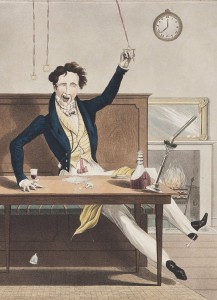 Until fairly recently, wine-related businesses typically were divided into those who sold wine and those who sold beverage wares. In Britain and America, continental European wines were most popular, with prices and availability affected by trade agreements, taxes, and wars. The wealthy could purchase wines from wholesalers or retailers or order from agents or vintners overseas. Through the mid-1700s, taverns played a major role in distribution to the general public. Tavern owners often acquired wine from merchants at nearby ports; rum via arrangements with sea captains or distillers; and beer or cider from local producers. Consumers could drink at the taverns or have containers filled to “take away.” Later in the 1700s, wine stores dominated the off-premises wine and spirits trade, perhaps because inexpensive small containers such as wine bottles were then readily available. These could be filled (or refilled) by importers or wholesalers and distributed to shops for resale.
Until fairly recently, wine-related businesses typically were divided into those who sold wine and those who sold beverage wares. In Britain and America, continental European wines were most popular, with prices and availability affected by trade agreements, taxes, and wars. The wealthy could purchase wines from wholesalers or retailers or order from agents or vintners overseas. Through the mid-1700s, taverns played a major role in distribution to the general public. Tavern owners often acquired wine from merchants at nearby ports; rum via arrangements with sea captains or distillers; and beer or cider from local producers. Consumers could drink at the taverns or have containers filled to “take away.” Later in the 1700s, wine stores dominated the off-premises wine and spirits trade, perhaps because inexpensive small containers such as wine bottles were then readily available. These could be filled (or refilled) by importers or wholesalers and distributed to shops for resale.
Merchants who sold glasses, decanters, and other wine equipage typically also carried other beverage and dinner wares. In America the majority of such objects were imported until well after the Revolutionary War. As average incomes increased, manufacturers and merchants offered a broader range of goods at different price points, and consumers who once had a single set of wineglasses could purchase a greater variety of sizes and shapes. Elegant decanters now joined, and gradually replaced, wine bottles on the table, and specialized items like corkscrews became popular. As the economy strengthened, there was also an increase in personalized goods, with items such as punch bowls and wineglasses being inscribed to celebrate special events and new trading ventures.
Related Themes:
